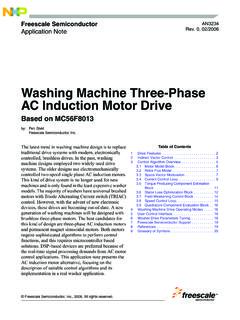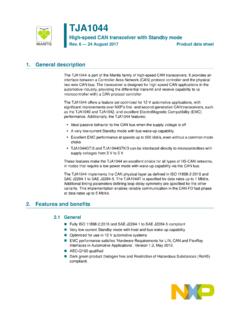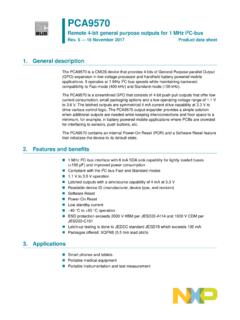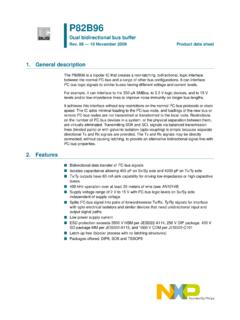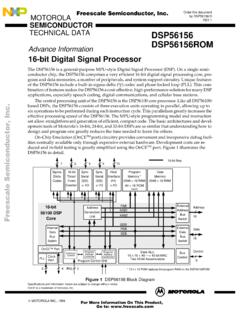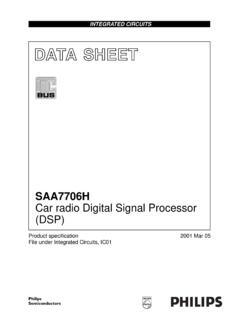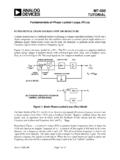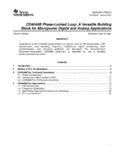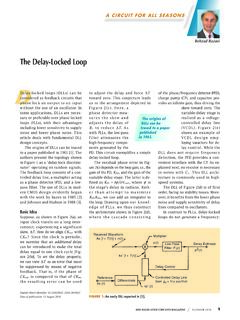Transcription of Phase-Locked Loop Design Fundamentals - NXP
1 Freescale Semiconductor, Inc., 1994, 2006. All rights SemiconductorApplication NoteDocument Number: AN535 Rev. , 02/2006 AbstractThe fundamental Design concepts for Phase-Locked loops implemented with integrated circuits are outlined. The necessary equations required to evaluate the basic loop performance are given in conjunction with a brief Design document contains references to obsolete part numbers and is offered for technical information purpose of this application note is to provide the electronic system designer with the necessary tools to Design and evaluate Phase-Locked Loops (PLL) configured with integrated circuits. The majority of all PLL Design problems can be approached using the Laplace Transform technique. Therefore, a brief review of Laplace is included to establish a common reference Phase-Locked Loop Design Fundamentalsby: Garth NashApplications EngineeringContents1 Introduction.
2 12 Parameter Definition .. 23 Type - Order .. 34 Error Constants .. 45 Stability .. 66 Bandwidth .. 107 Phase-Locked Loop Design Example .. 118 Experimental Results .. 189 Summary .. 1910 Bibliography .. 21 Parameter DefinitionPhase- locked Loop Design Fundamentals Application Note, Rev. Semiconductorwith the reader. Since the scope of this article is practical in nature all theoretical derivations have been omitted, hoping to simplify and clarify the content. A bibliography is included for those who desire to pursue the theoretical DefinitionThe Laplace Transform permits the representation of the time response f(t) of a system in the complex domain F(s). This response is twofold in nature in that it contains both transient and steady state solutions. Thus, all operating conditions are considered and evaluated. The Laplace transform is valid only for positive real time linear parameters; thus, its use must be justified for the PLL which includes both linear and nonlinear functions.
3 This justification is presented in Chapter Three of Phase Lock Techniques by parameters in Figure 1 are defined and will be used throughout the 1. Feedback SystemUsing servo theory, the following relationships can be 1 Eqn. 2 These parameters relate to the functions of a PLL as shown in Figure 2. Phase locked Loop es()11Gs()Hs()+------------------------- --------= is()= os()Gs()1Gs()Hs()+---------------------- -----------= is()=Type - OrderPhase- locked Loop Design Fundamentals Application Note, Rev. Semiconductor3 The phase detector produces a voltage proportional to the phase difference between the signals iand o/N. This voltage upon filtering is used as the control signal for the VCO/VCM (VCM Voltage Controlled Multivibrator).Since the VCO/VCM produces a frequency proportional to its input voltage, any time variant signal appearing on the control signal will frequency modulate the VCO/VCM.
4 The output frequency is Eqn. 3during phase lock. The phase detector, filter, and VCO/VCM compose the feed forward path with the feedback path containing the programmable divider. Removal of the programmable counter produces unity gain in the feedback path (N = 1). As a result, the output frequency is then equal to that of the types and orders of loops can be constructed depending upon the configuration of the overall loop transfer function. Identification and examples of these loops are contained in the following two sections. 3 Type - Order These two terms are used somewhat indiscriminately in published literature, and to date there has not been an established standard. However, the most common usage will be identified and used in this type of a system refers to the number of poles of the loop transfer function G(s) H(s) located at the origin. For example:LetEqn. 4 This is a type one system since there is only one pole at the origin.
5 The order of a system refers to the highest degree of the polynomial expressionEqn. 5which is termed the Characteristic Equation ( ). The roots of the characteristic equation become the closed loop poles of the overall transfer function. For example:Eqn. 6 ThenEqn. 7 ThereforeEqn. 8 Eqn. 9which is a second order polynomial. Thus, for the given G(s) H(s), we obtain a type 1 second order system. foNfi=Gs()Hs()10ss 10+()----------------------=1Gs()Hs()+0 C. E. =Gs()Hs()10ss 10+()----------------------=1Gs()Hs()+11 0ss 10+()----------------------+0==C. E. ss 10+()10+=C. E. s210s10++=Error ConstantsPhase- locked Loop Design Fundamentals Application Note, Rev. Semiconductor4 Error ConstantsVarious inputs can be applied to a system. Typically, these include step position, velocity, and acceleration. The response of type 1, 2, and 3 systems will be examined with the various inputs.
6 E(s) represents the phase error that exists in the phase detector between the incoming reference signal i(s) and the feedback o(s)/N. In evaluating a system, e(s) must be examined in order to determine if the steady state and transient characteristics are optimum and/or satisfactory. The transient response is a function of loop stability and is covered in the next section. The steady state evaluation can be simplified with the use of the final value theorem associated with Laplace. This theorem permits finding the steady state system error e(s) resulting from the input i(s) without transforming back to the time statedEqn. 10 WhereEqn. 11 The input signal i(s) is characterized as follows: Step position:Eqn. 12or, in Laplace notation:Eqn. 13where Cp is the magnitude of the phase step in radians. This corresponds to shifting the phase of the incoming reference signal by Cp radians: Step velocity:Eqn.
7 14or, in Laplace notation:Eqn. 15where Cv is the magnitude of the rate of change of phase in radians per second. This corresponds to inputting a frequency that is different than the feedback portion of the VCO frequency. Thus, Cv is the frequency difference in radians per second seen at the phase detector. Lim t()[]Lim s es()[]=t so es()11Gs()Hs()+------------------------- -------- is()= it()Cp=t0 is()Cps------= it()Cvt=t0 is()Cvs2------=Error ConstantsPhase- locked Loop Design Fundamentals Application Note, Rev. Semiconductor5 Step acceleration:Eqn. 16or, in Laplace notation:Eqn. 17Ca is the magnitude of the frequency rate of change in radians per second per second. This is characterized by a time variant frequency input. Typical loop G(s) H(s) transfer functions for types 1, 2, and 3 are: Type 1 Eqn. 18 Type 2 Eqn. 19 Type 3 Eqn. 20 The final value of the phase error for a type 1 system with a step phase input is found by using Equation 11 and Equation 21 Eqn.
8 22 Thus, the final value of the phase error is zero when a step position (phase) is , applying the three inputs into type 1, 2, and 3 systems and utilizing the final value theorem, the following table can be constructed showing the respective steady state phase 1. Steady State Phase Errors for Various System TypesType 1 Type 2 Type 3 Step PositionZeroZeroZeroStep VelocityConstantZeroZeroStep AccelerationContinually increasingConstantZero it()Cat2=t0 is()2 Cas3---------=Gs()Hs()Kss a+()------------------=Gs()Hs()Ks a+()s2--------------------=Gs()Hs()Ks a+()sb+()s3----------------------------- --------= es()11 Kss a+()------------------+----------------- ----------- Cps------ sa+()Cps2as K++()--------------------------------== et =()Limssa+s2asK++----------------------- ---- Cp0==so StabilityPhase- locked Loop Design Fundamentals Application Note, Rev.
9 SemiconductorA zero phase error identifies phase coherence between the two input signals at the phase constant phase error identifies a phase differential between the two input signals at the phase detector. The magnitude of this differential phase error is proportional to the loop gain and the magnitude of the input continually increasing phase error identifies a time rate change of phase. This is an unlocked condition for the phase Table 1, the system type can be determined for specific inputs. For instance, if it is desired for a PLL to track a reference frequency (step velocity) with zero phase error, a minimum of type 2 is root locus technique of determining the position of system poles and zeroes in the s-plane is often used to graphically visualize the system stability. The graph or plot illustrates how the closed loop poles (roots of the characteristic equation) vary with loop gain.
10 For stability, all poles must lie in the left half of the s-plane. The relationship of the system poles and zeroes then determine the degree of stability. The root locus contour can be determined by using the following 1 - The root locus begins at the poles of G(s) H(s) (K = 0 and ends at the zeroes of G(s) H(s) (K = ), where K is loop 2 - The number of root loci branches is equal to the number of poles or number of zeroes, whichever is greater. The number of zeroes at infinity is the difference between the number of finite poles and finite zeroes of G(s) H(s).Rule 3 - The root locus contour is bounded by asymptotes whose angular position is given by:Eqn. 23where #P (#Z) is the number of poles (zeroes).Rule 4 - The intersection of the asymptotes is positioned at the center of gravity :Eqn. 24where P ( Z) denotes the summation of the poles (zeroes).Rule 5 - On a given section of the real axis, root loci may be found in the section only if the #P + #Z to the right is 6 - Breakaway points from negative real axis is given by:Eqn.)

